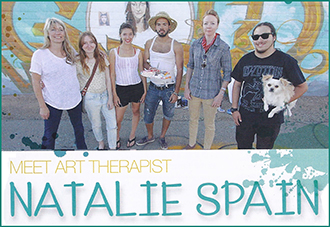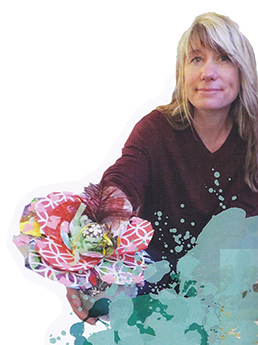Natalie’s art therapy work was recently featured in Kiki magazine!
(from Kiki Magazine, 12/2015)

Meet art therapist Natalie Spain
BY SUSAN WIDER
Natalie Noel Spain is an art therapist based in Santa Fe, New Mexico. As a licensed counselor she helps clients of all ages to create healthy relationships with themselves and those around them. Kiki contributing writer Susan Wider interviewed Natalie to learn more about how she uses art in her work.
Kiki Mag: When did you first discover your own love of art?
Natalie Spain: My fourth grade teacher noticed that I was always drawing. She hired me to do six watercolor paintings for her daughter’s nursery. She even paid me, and then she told me to consider it my first commission.
KM: How did you learn about the art therapy field?
NS: When I was nineteen I volunteered at a women’s center in Austin, Texas where I babysat children while their mothers were in therapy. One little boy had witnessed some domestic violence and hadn’t spoken in six months. I had the children draw pictures and then talk to me about what they had drawn and this little boy spoke right up. For me, this was a dramatic way to see the healing power of art. I wanted to know more about how art is connected to trauma so I called the locai community college art department. They suggested I investigate the field of art therapy.
KM: What kind of education do you need to become an art therapist?
NS: My undergraduate education is in psychology and fine art-I studied welding, photography, painting, drawing, watercolor, oils, and lithography. Then I got a Master of Arts degree in marital and family counseling with an emphasis on art therapy.
KM: Tell us about how you use art therapy with your clients.
NS: Art is an easier way for people to communicate if they can’t find the words to describe grief or trauma or sadness. I often start by having people draw symbols of themselves. I might ask a child to draw a family portrait, or have an adult draw an emotion. We might use collage or painting or sculpture. I’m trained to see the signs of trauma in art so I might say to a person, “Tell me about this red, or this blue;’ or I’ll ask them to describe their art to me. I can also show them how aspects of their pictures might represent a positive emotion that they didn’t even realize they felt.
KM: Does art therapy work for people who aren’t particularly artistic?
NS: It actually works better. Artists might want to achieve a particular effect and that can get in the way. Stick figures work just fine.
KM: Can you offer Kiki readers an art therapy exercise to do at home next time they feel a little too much stress?
NS: Keep a pad of sketch paper handy and some colored pencils or oil pastels. Draw a symbol of yourself or scribble and fill a page with whatever you want. You can do this before you start your homework or as a homework break. It’s private, like an art journal. It’s not about how it looks; it’s about your own expression.
